#history of call of duty as an esport
Explore tagged Tumblr posts
Text
Overwatch: the art of writing bad stories on purpose

Clocking in at just over 4k words: a semi-coordinated rant on the topic of Blizzard's history of lawsuits, Overwatch'es history of canonical queerness, and the strange marketing techniques that tie the two topics together. Written by someone who got into the game less than a week ago and likes it in a hatewatch "I love garbage" sort of way, intended for those less familiar with the topic at hand. I tried to source claims but it didn't work so let it be known that I did actual research but I'll probably get stuff wrong anyway so I tried to be funny about it here we go:
Section 1: Frat Boy Snowstorm and it's attempts at being progressive.
Try to focus. This is the most boring part.
So as I hope you all know by now, Blizzard is a pretty shit company. I say shit, because controversial sounds too unbiased. Most of us are familiar with the lawsuits against the company relating to sexual assault charges, unsafe working conditions for female employees and a quote "frat boy environment," of which they've been under fire for since 2018, but recently (early April '23 to be precise) they've also faced a lawsuit for sneakily coming up with a way to underpay their eSports champions. (Both of these are easy to look up if you want more info.) However, the company is a giant, that along with Overwatch released Call of Duty and a bunch of other games I don't recognise (fuck me I'm not an FPS person,) and, aside from the money they easily paid out, they really haven't faced any major consequences for their scummy behaviour.
This is exactly what they want, of course: for the whole thing to blow over as quickly as possible. Keep this in mind as we move on. That's the whole reason Section 1 exists: to remind you that Blizzard, like Disney, is a Big Corporate Company that will go to ridiculous lengths to make sure that the actually relevant controversies are forgotten in favour of smaller stupider shit.
If there's one thing Blizzard loves to do more than make their female employees uncomfortable, it's to tote around their progressiveness. Of course, this usually doesn't extend to Call of Duty or any of their more "grounded" "gritty" and generally masculine domains, but Overwatch specifically is a testing ground for all kinds of bullshit and we can't go a season without one billion articles about "Overwatch first game to have character of xxx nationality on playable roster" etc etc etc. People absolutely shit their pants every time the game announces a new queer hero or whatever, because since it's a Big Corporate Company and it's just barely achieving the bare minimum of inclusivity, of course, that's got to be a big deal right? Except of course that like Disney, Blizzard will do literally fucking anything to make sure their games stay relevant and that more people buy and play them, and these attempts at inclusivity can be assumed to be preformed mainly out of a desire to make money and cover up their scandals, and not because the people who call shots actually care. It becomes incredibly clear how Blizzard sees inclusivity as an idea when you consider their viral invention from last year, the Diversity Space Method.

To some of you this may look like a good thing at first, and originally I think it was, as the idea was to keep track of how many of their characters weren't any of these things displayed above so that they could keep that number down, but as soon as someone came up with the idea to assign a certain number of points to each character, the whole concept crashes and burns. You see, according to this chart here, (and as another Tumblr user famously put it), Torbjörn (3) is older than Lucio (2) is black. And I'm pretty damn sure that's not how that works.
No doubt a percentage of the artists and writes for the game had some sort of passion. After all, there is genuine treasure to be found in the character designs, animations and even some of the voice acting. But you know how it is when it comes to inclusivity; the artists so often never get to do more than drop hints and leave people guessing. Which leads us neatly into the next section.
Section 2: This game's kinda shit!
And I don't mean the game itself. Idk about that, I never played it (and my friends who do all have wildly varying opinions.) I am talking about the stories. When I first started "researching" (hatewatching) the shorts and comics for this game, I was angrily wondering why they all felt so hollow. It was like looking at AI generated art, it was like looking into the eyes of what you thought was a person and seeing two camera lenses staring back, it felt empty, it felt bland despite all the good character designs and the lore and the concepts and the colors and the nice clean lines. Something was missing, and it was uncanny as hell! Eventually though, I managed to narrow it down to a few key issues:
A lot of comics and shorts feel like ads above eveyrthing else, they're made to sell the game rather than be good, and they therefore lack passion.
Possibly as a result of this, they operate almost entirely on "tell don't show" rules, thereby feeling even more empty.
These stories still manage to lack substance and they don't really canonise a lot about the world or characters, especially regarding relations between characters, and,
the really interesting storylines are usually left uncontinued or unexplored, possibly due to aformentioned lack of passion and an egotistical but sadly fulfilled hope that people will download the game or at least read the rest of the comics to find out more.
All this put together make for a very strange experience in which you can, if you squint, see the fuzzy outline of a good story, good worldbuilding and interesting characters, and imagine that the details make sense. Which, granted, is usually what people do. If you use your brain or have experience in writing, however, it all falls apart.
Section 3A: Overwatch is a knock-off
Well, not exactly. But it does have a strange habit of borrowing from other games. For example, did you know I'm a TF2 fan? Probably. Did you know each individual TF2 class has an Overwatch equivalent? Me neither, until now. Scout and Tracer, Medic and Mercy, Sniper and Widowmaker, Spy and Sombra, hmm I'm sensing a pattern here, Demo and Junkrat (we'll get back to him later,) and so on.
"That's a coincidence," you say. "They're similar games, of course there are equivalents," you say. To that I says: you may be right. We may all collectively be overthinking this. We may all also collectively be overthinking the Omnic crisis as a whole and why it's so damn similar to Fallout's synths, they've both got robot racism and violent groups who want to kill the robots one of which is in Australia, which is a plot point in TF2 as well oh look at that, but again I'm sure it's all a big fucking coincidence right and sorry sorry I'll stop now.
It is actually genuinely possible that those are coincidences, no sass intended, but considering how Blizzard operates on the whole, I doubt it. They've already proven to be rather lazy with their stories. There's nothing wrong with having similar ideas or being inspired, but when it's as noticeable as this, along with everything else, I just can't help but feel disappointed.
Section 3B: Overwatch is also a porn category
Oh yeah, speaking of never properly canonizing relationships between the characters (and aging their underage characters up to eighteen for hitherto mysterious reasons, and releasing all those horny fanservice skins,) here's an utterly ridiculous fact: when Overwatch dropped in 2016, quite a lot of people didn't know it was a game because there was so much (animated, drawn etc) porn of it that it flooded and quickly rose to the top of the "games" category on most popular sites (hard to source for obvious reasons, but I've had a friend check for me.) It still sits up there, by the way, surpassed only by funny space bean game (I'm not kidding.) Why? Two reasons. One: all the game's female characters are impossibly beautiful and (in every case but like two post-launch releases) skinny and generally conventional as well. No surprise there. Two: the game models are well rigged, high quality and incredibly easy to get at, making it so that people can tank them down and use them for whatever they like without issue. Rumour has it that this is on purpose.
My question is, what has this influx of smut done to the game? You see, if there's one thing Blizzard loves more than making their female employees uncomfortable, bragging about inclusivity, and copying other games, it's pandering. And they pander to everybody, or at least to as many people as possible, usually all at the same time if they can get away with it. This, I have to theorise, is why all the characters seem to be flirting with one another, but only one or two actual relationships are canon. They simply don't want to piss off any part of their demographic, which they force as wide open as possible because money money money money money. This means embracing the porn and making sly references to that part of the fanbase with skins, voice lines, and odd comments in interviews.
Anyway, back to the lawsuits, or rather the consequences of them. You see, canon queerness in Overwatch comes in threefold. This is the story of two thirds of it.
Section 4: Toy Soldier and Knock-off Scout Adventures
This is Soldier 76. And he's gay.
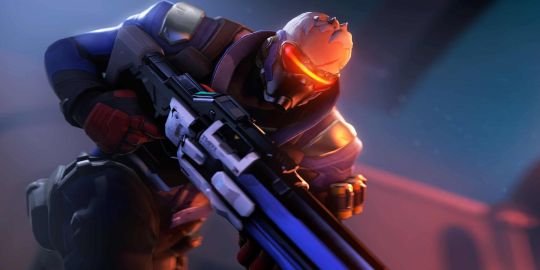
Everybody clap for Blizzard now. It's coyly canonised in a short story titled Bastet. 76 here was never a very popular Overwatch character, lore wise, so I guess this move makes sense. I can see why, too. He's very plain and simple design wise, almost grounded, but not enough that you notice it at a glance. He looks like a plastic toy. Anyway, his queerness wont piss off too many dudebros long-term, since fewer people play him, but it gives everybody else something to chew on, so everybody wins right?. When was Bastet released again? Oh, January of 2019? What else happened around that time? The settling and aftermath of the first lawsuit? Great. That totally wasn't a cover-up for anything. Definitely not.
It's not like 76 is the first character to be confirmed as queer though. Blizzard's favourite Overwatch character Tracer is too, being confirmed as having a girlfriend named Emily all the way back in 2016.

That's good right? I mean, that was before the controversy even started! Surely they did this for normal, innocent reasons and oh who the fuck am I kidding she's a conventionally attractive female character kissing another conventionally attractive female character in a game dominated by male players with male devs and a porn category more expansive than the Bible and we know damn well why that happened.
We can but pray that someone who was in on this gave a shit. Maybe the artist. The writer. Somebody. But this is a barren and cold world and I dare not hope even for that.
Not to mention, both of these things were distinctly one-off notes. It's mentioned once, and then never again, and after 2019 there was a four year radio silence on the whole subject of queer characters that didn't change until the release of OW2. And yet, Blizzard loved to brag about how inclusive they are at every turn even back then. "Look at us," they say, as the characters stare at you from the computer screen with their dead, hollow eyes, "look at how good we are! Please buy our game."
The status quo would change significantly in 2023, however, with the introduction of their latest addition to the roster; Lightweaver. Lifeweaver. Lightweaver? Wait hold on
Section 5: The most annoying twunk to ever grace the earth flings you into the stratosphere

This is Niran "Bua" Pruksamanee, also known as Lifweaver.
He debuted on the 11th of April, 2023, and he's The First at a lot of things, which, of course, made headlines. "First Thai character in a major FPS game" was probably the most common one. I'd feel better about that if I didn't know it's most likely the result of Blizzard trying to cash in inclusivity points. The second First he has is the more controversial one, however: First Overwatch character to be confirmed queer on launch. That's right, after four years of Jack Shit, they're back on it! And, well.
You see, to fully understand my emotions about this you need to know who Lifeweaver is. Despite Overwatch being a game with Mr black-hole-head toes-out "yet another poor-taste representation of DID" Sigma and a football-sized foul-mouthed hamster in a mechsuit in it, neither of them manage to be very funny. Lifeweaver, however, is objectively fucking hilarious, for these main reasons:
His amicable, light hearted healer-character personality clashes with his backstory, in a way that actually works. Lifweaver is a scientist who dropped out of a prestigious academy to stop people from trying to A: steal and B: jail him for his invention: biolight (which is exactly what it sounds: light that grows like plants, or vice versa.) Because of this biolight stuff, he is canonically wanted in seventeen countries and counting. And yet he's so glad to be here, you can hear the smile in his voice, he's kind, he's carefree. And he flirts.
With, like, everybody. Notably Mercy, and apparently he was roomates with Symmetra and speaks very fondly of her. On top of that he's (very) low-key implied to at least want to flirt with Roadhog of all people (can't say I blame him, anyway I'll get back to him,) and, uuh. Baptiste? Who's Baptiste? Nope, never heard of him. Ex-mercenary who regrets his actions and now plays support to make up for all the murder he did? Is what you may be asking yourself. Seriously, nobody talks about Bap. Maybe that's why he's being brought back into semi-relevance now, as Lifeweaver canonically (and smoothly) asks him on a date at a nice restaurant, to which he, unsurprisingly, says yes. He's always been very flirty himself. That should technically make it four canon queer characters in the game, but Baptiste still has some plausible deniability because of his personality, so arguments can still be argued, as they say.
Back to Lifeweaver. More specifically his playstyle. This bright pink healer wants nothing but to help people and further science! His players, however, will gladly ruin your day for shits and giggles. You see, it's become a bit of a gimmick of Overwatch as a whole to let you move your enemies around the battlefield. Junker Queen has her magnetic gauntlet thing, Roadhog has a hook, everybody and their mom have knockback, etc. Lifeweaver, however, can move his friends around. He has an ability to pull his teammates towards himself which he can also use to sling some of them across the map if they cooperate and/or move wrong. He can also raise a platform under any player that tosses them (or their lifeless corpse) into the air. This is incredibly useful in a coordinated team where everybody's using voice chat, eg. the way Overwatch is actually meant to be played. Overwatch is, however, never played how it's meant to be played. Hilarity ensues.
The circumstances of Lifeweaver's release. Here's the thing. On the 4th of April 2023, exactly one week before his release, Blizzard was sued again, this time for underpayment and mistreatment of their eSports champions. Although it's impossible to create a whole character in a week, it's fully possible that at least some parts of Lifeweaver's personality and some of the stuff he calls to canon (we'll get to The Thing later I promise, be patient,) were influenced by this. It's comically well timed that such a controversial character dropped so soon after that scandal, and while the model and animations were definitely finalized before that, any given set of voice lines could've been phoned in on the night of April 4th for all we know.
Put together, all of this is either infuriating or ridiculous. Some days it's one, some days the other, and some days, I'm just not sure. Originally I hated Lifeweaver. He felt predictable to me, a cheap coverup, a stereotype, and an annoying one at that. But eventually I sort of came around, because he got so annoying that I kind of had to respect him for it. From there, I eventually ended up here. And I think a lot of other people, notably the players themselves, felt the same. Go figure.
Section 6A: No scummy marketing tactic is complete without queerbait!
Valuable life lesson: it is very, very hard to tell wether or not something is queerbait by looking at the media itself. The possibilities that the perceived homoerotic tension is an accident, or a hint that's left vague for stylistic reasons, or simply a slow burn, are all present and impossible to rule out. The real way you find out if something is queerbait is by looking at the actual marketing. Listen to what devs say in interviews. Look at promotional material. Et cetera. Because I don't have the patience to watch those interviews, I can't actually say wether what I'm about to discuss is queerbait or a series of unfortunate accidents made as a result of Blizzard's bad habit of pandering, so I'll let you form your own conclusions and possibly go look it up on your own. (And then come back here and tell me about it because I'm so so curious.) I am probably going to go into excruciating detail on this next part. I am so sorry. I can't help but have favourites. So without further ado;

This is Jamison "Junkrat" Fawkes.
Or at least, it was back in OW1. (I promise the full body transparent background image is crucial.)
Anyway, this absolute bastard is a favorite of mine. (Having favourite OW characters? I am cringe but I am free.) He was in the game from launch, and remains one of the more interesting and, shall we say, least soulless characters in the game to this day. Not that there's that much to him. He never shuts up, he's clinically insane as a result of several concussions and a lot of radiation, and he really really likes blowing things up. Together with Roadhog, he's a freelance mercenary with little to no morals whatsoever, taking on whatever job gets them both cash, action, and buildings to explode.

Oh yeah, right. Mako "Roadhog" Rutledge, the quiet, stoic and occasionally terrifying two meter tall shit brickhouse with a stitched gas mask shaped like a pig snout and a massive hook on a chain. Sadly, although he's crucial to the segment, I can't really discuss him as much as I would like to because he has like five voice lines in total (an exaggeration) and half of them are just him telling Junkrat to shut the fuck up (not an exaggeration.) "Stoic, silent characters can be interesting without speaking," I hear you say. Yes, I reply, if they're well written. But this is Overwatch. Never ever get your hopes up about Overwatch.
Anyway, the trash rat and Mr Whole Hog here have an interesting history. Originally, they were simply friends, running around and doing Hilarious Antics™ (that were never very funny, other than in concept.) They feature in several comics together (none of which are very good,) they chat a lot in game and they have their own animated short called The Plan (which is the first Overwatch thing I ever consumed, also not very good, but hey, it landed me here.) And before I get into the queerbait part of this segment, let me just say that studying just this small part of Overwatch tells volumes about the writing all on its own. The tell-don't-show, the inconsistencies, the rampant ludonarrative dissonance... Stars, the comics want you to take Roadhog so seriously. They're leaning super hard into the edge with a brutal backstory and focus on making him as menacing as possible. Meanwhile, in game he, and I cannot stress this enough, walks around ass out the entire time. Google at your own risk. Don't say I didn't warn you!
There is this one voice line, triggered when interacting with one another, where Junkrat says somthn' like "You'll hook 'em, I'll cook 'em!" and Roadhog just sighs in frustration, but then there's another line, triggered the same way, where HE begins the saying, "I'll hook 'em..." "And I'll cook 'em!" In short, fuck you consistency, and this contrast could be really interesting if it was well written. But of course Overwatch will Never Ever elaborate on this, as per usual.
As the years went by, however, things got... A bit weird. Junkrat has always been friendly. According to him, he and Hoggie (he calls him that, not me) are the bestest of friends. And although Roadhog acts as though he hates Junkrat a lot of the time, this is very obviously just tsundere behaviour used to mask the fact that he does really like him quite a lot. But in what way? "Gayass," said half the fandom. "No, fuck you," said the other half, "this is clearly a father-son dynamic." "You're all homophobic," said the first half. "Maybe we are," said the second, "what are you gonna do about it?"
And Blizzard... Did nothing. Well, they did canonise their ages at some point, and there is about two decades inbetween the two (Junkrat is allegedly 25 although I find that hard to believe, I mean look at him, and RH is in his late forties) which one would assume suggests their support of the father-son thing, right? Man, if only it were that easy. First of all, the writing is so nondescript and vague that their actual dynamic doesn't resemble a parental one even in the slightest, especially not on Junkrat's tounge, and seeing as he's both more affectionate and more talkative I'll lend that it's appropriate weight. Predictably, there is also one line that is inexplicable, unexplainable and clearly an innuendo, where if you run Junkrat and eliminate an enemy RH, he'll say something like "I guess we know who's on top now, don't we?" This doesn't appear to be a reference to anything, trust me, I've tried to check. Excuse me while I take a sledgehammer to Blizzard's servers. Again, we can't assume anything's ever on purpose, but c'mon. Who greenlit that?
So, unsurprisingly, Blizzard is being annoyingly non-commital again, so as not to piss off either half of their fanbase. Things went kinda quiet after that. Anything released was, again, purposely vague.
And then OW2 happened.
Section 6B: Subtlety, lack thereof, and the art of applying a metallic texture to a default Blender orb
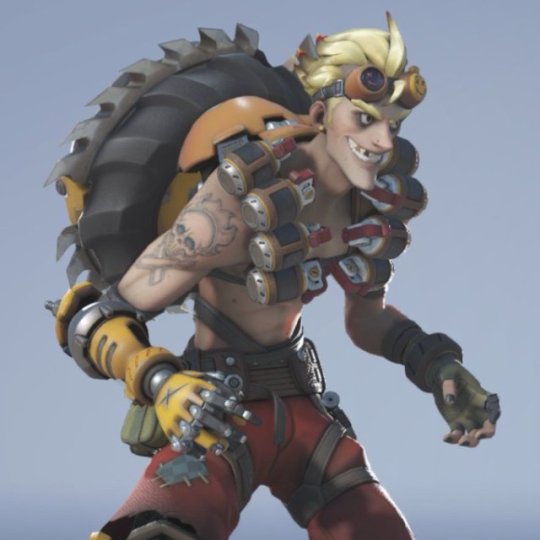
This is Junkrat, as his current in game model. Sad, right? How they forced him to take a bath before letting him into OW2? How they regrew his hair and ripped off his cooler patches? It's a fucking travesty. People are calling him "Cluttermouse" as a joke now. Why would they do this? They massacred my boy.
Anyway, if you're observant you'll notice he's got an earring now. Yeah, on his right ear. Yeah. What's that? You were on Tumblr in 2016? You remember all the circling posts about "earring on the right ear means person wearing it is gay" posts? You grew up a bit and assumed that was made up or blown out of proportion? You asked your mom one day and she confirms it was a very widely known symbol until around the century change? Some fans must've noticed. Most of them didn't, though, because most of them are twelve. Anyway, I tell myself (and you) that it doesn't actually have to mean anything. If you look at the design again you'll see Rattie here is very asymmetrical, and leaned to his-right-your-left, both of his prosthetics being on that side. (He even walks unevenly, which I love.) It's likely that the modellers simply had no clue about the earring symbolism thing, and just wanted to play into that asymmetry. Right?
...and then Lifeweaver dropped.
And then everyone lost their fucking minds.
Ya see, dearest readers (thank you for making it this far,) Lifweaver, Pink Petal Supporthero McGoodguy, has not one, but two conversations with Junkrat in game. One of them feels fairly normal, with them discussing the price on Lifeweaver's "noggin" and laughing about it a bit. The other one, oh boy, the other one goes like this:
🌸"Are you and Roadhog together?"
🐀"Do~ you ever see us apart?
🌸"No. I meant: are you couple?"
🐀"Yes!! A couple of dashing rouges! Not sure... What you're missing here."
Yeah. I'd lose my shit too. I guess I kind of did, but not for the reason you think. You see, this right here, in terms of pure writing talent, is fucking genius, because it manages to be controversial without actually confirming anything. By that I mean, that because Fawkes said "yes" quite enthusiastically, the half of the fandom that said "gayass" think he meant yes, but because he noped out of that yes with the "couple of dashing rouges" bit, the other half of the fandom think he meant no! This is where I really start to wonder if they called Junkrat's voice actor at 2 in the morning and went "hey bud take a few extra grand and help us record another few lines will you? We just got sued again."
This shit is simultaneously funny as hell, sad, and absolutely infuriating. In reality, Junkrat has approximately two braincells rattling around in his skull, of which he is constantly frying, due to all the concussions. He probably doesn't even know what his relationship to Mako is. That might've been the case, and it would've been a good joke, had Overwatch been a well-written game. Sadly, it's all shitfuck at worst and boring at best, and this latest little oddity just makes me even more convinced that Junkrat and his partner have been banished to Queerbait Limbo for the foreseeable future.
Section 7: In conclusion,
Blizzard is shitfuck company, Overwatch is shitfuck game, I spent at least three hours writing this up and probably more editing it together and in less than a month, it's June and Overwatch'es first in-game pride event drops. Needless to say, I'm scared.
How much time did you waste reading? Did I state fake news? Do you have additional trivia? Do tell. I'm so curious. This has been four thousand words of nothing. Goodbye.

#essay#rant#long post#blizzard entertainment#overwatch#uuuuuuu i spent hours on this#btw i am not ripping on your favourite characters I feel bad for them for having shit creators and they're my ocs now#i won them over in the divorce. g'bye.#blizzard#bbugseye taps#tjs worst fix ever
34 notes
·
View notes
Text
The Rise of Online Gaming: Revolutionizing Entertainment and Connecting the World

In recent years, online gaming has evolved from a niche hobby to a mainstream entertainment phenomenon, reshaping the way we play, interact, and experience digital worlds. The rapid growth of the gaming industry, fueled by advancements in technology, has introduced new forms of interactive entertainment that cater to diverse audiences. Whether you’re a casual player enjoying a few rounds of mobile games or a competitive esports athlete, online gaming offers something for everyone.
This blog post delves into the rise of online gaming, its impact on society, the types of online games, and the future of this rapidly growing industry.
A Brief History of Online Gaming
While gaming itself has been around for decades, the concept of playing games online has only been a reality since the late 20th century. The early days of online gaming were marked by simple text-based games and basic multiplayer experiences that required a dial-up internet connection. In the 1990s, as broadband internet became more widespread, online gaming began to grow exponentially. Games like Warcraft II, Doom, and Quake were among the first to allow players to connect with one another over the internet. top5toto
As internet speeds improved, so did the gaming experience. In the early 2000s, online multiplayer games like World of Warcraft (WoW) and Counter-Strike captivated millions of players worldwide. These games not only introduced multiplayer functionality but also fostered the creation of global communities and competitive gaming scenes.
With the advent of mobile devices, gaming shifted once again, bringing new opportunities for gaming on-the-go. The rise of smartphones enabled players to engage in casual online games, such as Candy Crush, Clash of Clans, and PUBG Mobile, further cementing online gaming’s place in popular culture.
The Appeal of Online Gaming
There are several factors that contribute to the widespread appeal of online gaming. Let’s take a closer look at what makes it so attractive to millions of players across the globe:
1. Social Interaction and Community Building
One of the most significant reasons for online gaming's success is the social aspect. Online games allow players to connect with others, share experiences, and build lasting friendships, all from the comfort of their homes. Many online games offer voice chat, text communication, and team-based gameplay, which helps players form relationships with others who share similar interests.
Multiplayer online games such as Fortnite, League of Legends, and Minecraft boast thriving online communities, where players join guilds, participate in tournaments, and collaborate on in-game projects. These communities often extend beyond the virtual world, with players interacting on social media platforms, creating fan content, and even organizing meetups or conventions.top5toto
2. Competitive Gameplay
Another driving force behind the popularity of online gaming is the opportunity for competition. For many players, online gaming is not just about entertainment; it’s about testing skills, climbing leaderboards, and proving their abilities in a global arena. Online games like Call of Duty, Valorant, and Dota 2 offer high-stakes, skill-based environments where players can go head-to-head with others from around the world.
Esports, the professional competitive gaming industry, has exploded in recent years. Major esports tournaments now offer substantial prize pools, with millions of viewers tuning in to watch the world’s best players battle it out for fame and fortune. Esports events, like the League of Legends World Championship and The International (Dota 2), are broadcasted live on platforms such as Twitch and YouTube, attracting large audiences and sponsorship deals.
3. Constant Updates and Expanding Worlds
Online games are unique in their ability to evolve over time. Many developers regularly update their games, adding new content, features, and events to keep the experience fresh and engaging. This ongoing support ensures that players stay invested in the game and continue to enjoy new experiences.
For example, Fortnite is known for its frequent in-game events, seasonal updates, and collaborations with popular franchises. Similarly, World of Warcraft releases major expansions that introduce new regions, quests, and gameplay mechanics, keeping the world of Azeroth alive for more than 15 years.
4. Accessible to All
Online gaming is also highly accessible, with a wide variety of games available for different skill levels, devices, and budgets. From free-to-play mobile games to premium PC or console titles, players can find games that suit their preferences. Whether you prefer strategy, action, role-playing, or puzzle games, there’s something for everyone in the online gaming world.
Furthermore, the growth of cloud gaming services such as Google Stadia, Xbox Cloud Gaming, and NVIDIA GeForce NOW allows players to stream high-quality games directly to their devices, even if they don’t have the latest gaming hardware. This makes gaming more accessible to individuals who may not have access to powerful gaming PCs or consoles.
Types of Online Games
Online gaming encompasses a wide range of genres, each catering to different types of players. Below are some of the most popular types of online games:
1. Multiplayer Online Battle Arena (MOBA) Games
MOBA games, such as League of Legends, Dota 2, and Smite, are centered around strategic, team-based combat. Players control individual characters with unique abilities and work together to defeat the opposing team. These games are popular in the esports scene, with major tournaments held worldwide.
2. Battle Royale Games
The battle royale genre has seen tremendous growth in recent years, with games like Fortnite, Apex Legends, and PUBG leading the charge. These games are characterized by large player counts, shrinking play areas, and the goal of being the last person or team standing. The combination of survival gameplay and intense combat has made battle royales a global sensation.
3. Role-Playing Games (RPGs)
Online RPGs such as World of Warcraft, Final Fantasy XIV, and Guild Wars 2 allow players to immerse themselves in expansive virtual worlds. Players can create and customize characters, embark on quests, and interact with other players in persistent online worlds. These games often feature rich narratives, deep character progression, and cooperative gameplay.
4. First-Person Shooter (FPS) Games
FPS games like Call of Duty, Counter-Strike: Global Offensive, and Overwatch focus on fast-paced combat where players view the game from a first-person perspective. These games are known for their competitive nature and require quick reflexes and precision aiming. Many FPS games offer both casual and ranked modes, catering to a wide range of skill levels.
5. Casual Games
Casual online games are simple, easy-to-play titles that don’t require a significant time commitment. Games like Candy Crush, FarmVille, and Among Us fall into this category. These games are often mobile-focused and are designed for short, enjoyable sessions that can be played anywhere.
The Impact of Online Gaming
1. Cultural Influence
Online gaming has become an integral part of popular culture, influencing everything from fashion to music to film. Gaming icons like Super Mario, Master Chief from Halo, and Kratos from God of War have become cultural symbols recognized even outside the gaming community. The popularity of online games like Fortnite has also led to in-game concerts and crossovers with major brands and celebrities, blurring the lines between gaming and mainstream entertainment.
2. Economic Growth
The online gaming industry has become a multi-billion-dollar sector, with video game sales, in-game purchases, and esports generating significant revenue. The global gaming market is projected to continue growing, driven by new technologies, increased mobile gaming adoption, and the expansion of online multiplayer experiences.
3. Social Connections
For many players, online gaming serves as a social outlet. With the ability to communicate and play with friends, as well as meet new people from around the world, gaming fosters a sense of community. It has also provided an avenue for people to build careers as streamers, YouTubers, and professional esports players.
The Future of Online Gaming
The future of online gaming looks promising, with new technologies such as virtual reality (VR), augmented reality (AR), and artificial intelligence (AI) poised to take gaming experiences to the next level. VR gaming, in particular, offers a more immersive experience, allowing players to interact with virtual worlds in new ways.
Cloud gaming is also expected to revolutionize the industry, allowing players to stream high-quality games on any device without the need for powerful hardware. As internet speeds continue to improve globally, the potential for cloud gaming to become mainstream is enormous.
Moreover, as online gaming becomes more integrated into social platforms, we can expect to see greater emphasis on virtual spaces where players can socialize, create content, and participate in virtual events.
Online gaming has become a global phenomenon, attracting millions of players who engage in a variety of genres and experiences. From competitive esports to casual mobile games, online gaming continues to shape the way we play, interact, and socialize. With technological advancements on the horizon, the future of online gaming promises even more exciting and immersive experiences.
Whether you’re a casual gamer or a professional esports competitor, online gaming offers endless opportunities for fun, connection, and competition. So, fire up your favorite game and join the millions of players around the world who are shaping the future of entertainment.
1 note
·
View note
Text
October 2024 game releases
More info on Gamerspine
Forever Space: First Person Edition - STEAM - 2024/10/01 Jet Fighters with Friends 2 - STEAM - 2024/10/01 My Puppy - STEAM - 2024/10/01
Nuclear Lizard Island Rampage - STEAM - 2024/10/01 Throne and Liberty - XS STEAM PS5 - 2024/10/01 KILL KNIGHT - STEAM - 2024/10/02 Pinball Spire - STEAM - 2024/10/02 Esports History - STEAM - 2024/10/03 Garden of the Sea - STEAM - 2024/10/03 Hell of an Office - STEAM - 2024/10/03 Parcel Corps - STEAM - 2024/10/03 Wizard of Legend 2 - STEAM - 2024/10/03 Cult of the Frog - STEAM - 2024/10/04 NHL® 25 - XS PS5 - 2024/10/04 REYNATIS - NSW PS4 PS5 STEAM - 2024/10/04 Japan SpongeBob SquarePants™: The Patrick Star Game - Microsoft Store NSW XS STEAM XONE PS4 PS5 - 2024/10/04 Until Dawn (2024) - PS5 STEAM - 2024/10/04 Along long road - STEAM - 2024/10/06 Anima Flux - STEAM - 2024/10/07 Asylum of the Forsaken - STEAM - 2024/10/07 Beloved Rapture - STEAM - 2024/10/07 It Paints Me - STEAM - 2024/10/07 Necro Story - STEAM - 2024/10/07 Phoenix Springs - STEAM - 2024/10/07 Rebots - STEAM - 2024/10/07 SILENT HILL 2 (2024) - PS5 STEAM - 2024/10/07 LEGO® Harry Potter™ Collection - PS5 STEAM XS - 2024/10/08 Space Memory: Dogs - STEAM - 2024/10/08 Subterror - STEAM - 2024/10/08 GhostlyRyokan - STEAM - 2024/10/09 Hidden in my Paradise - STEAM - 2024/10/09 My Happy Village in the Kingdom - STEAM - 2024/10/09 Bloodless - NSW - 2024/10/10 DRAGON BALL: Sparking! ZERO - XS PS5 - 2024/10/10 Metaphor: ReFantazio - Microsoft Store XS PS4 PS5 - 2024/10/10 Sky Oceans: Wings for Hire - STEAM - 2024/10/10 Europa - STEAM - 2024/10/11 HeartWood - STEAM - 2024/10/11 My Fantasy Hostess Club - STEAM - 2024/10/11 Predator: Hunting Grounds - XS PS5 - 2024/10/12 World Rally Arcade - STEAM - 2024/10/13 Highland Huntress - STEAM - 2024/10/14 Plattis - STEAM - 2024/10/14 Neva - NSW STEAM PS5 XS - 2024/10/15 New World - XS PS5 - 2024/10/15 The Gate - STEAM - 2024/10/15 TRAILCAM - STEAM - 2024/10/15 Cats Hidden in Germany - STEAM - 2024/10/16 Days Of Haze - STEAM - 2024/10/16 A Quiet Place: The Road Ahead - PS5 XS STEAM - 2024/10/17 Citadelum - STEAM - 2024/10/17 Super Mario Party Jamboree - NSW - 2024/10/17 Unknown 9: Awakening - STEAM - 2024/10/17 Cyber Soldier - STEAM - 2024/10/18 The Halloween Incident - STEAM - 2024/10/18 VHS Collection: Goodnight Me - STEAM - 2024/10/18 K-Bot - STEAM - 2024/10/21 Nuclear Nightmare - STEAM - 2024/10/21 Worshippers of Cthulhu - STEAM - 2024/10/21 Claws & Chaos - STEAM - 2024/10/22 Inventory Quest: Hero's Hoard - STEAM - 2024/10/22 Lynked: Banner of the Spark - STEAM - 2024/10/22 No More Room in Hell 2 - STEAM - 2024/10/22 Streets of Rogue 2 - STEAM - 2024/10/22 Wilmot Works It Out - STEAM - 2024/10/23 Call of Duty®: Black Ops 6 - PS4 XS STEAM XONE PS5 Battle - 2024/10/24 Romancing SaGa 2: Revenge of the Seven - PS5 NSW STEAM PS4 - 2024/10/24 SONIC X SHADOW GENERATIONS - XONE XS EGS STEAM PS4 PS5 - 2024/10/24 Yakuza Kiwami - NSW - 2024/10/24 Your wife oh - STEAM - 2024/10/24 Runny Bunny - STEAM - 2024/10/25 Ys X: Nordics - PS4 STEAM NSW PS5 - 2024/10/25 [ANOMALY TAPES]: Beyond Reality - STEAM - 2024/10/28 Fruitbus - STEAM - 2024/10/28 Inferni: Hope & Fear - STEAM - 2024/10/28 Moon Mystery - STEAM - 2024/10/28 NIMRODS: GunCraft Survivor - STEAM - 2024/10/28 There's No Monsters - STEAM - 2024/10/28 Life is Strange: Double Exposure - PS5 XS NSW STEAM - 2024/10/29 Monument Valley 2 - Netflix - 2024/10/29 pedalverse - STEAM - 2024/10/29 Post Trauma - STEAM - 2024/10/29 Pokémon TCG Pocket - AND IOS - 2024/10/30 Diced Up! - STEAM - 2024/10/31 Dragon Age™: The Veilguard - EGS XS PS5 STEAM - 2024/10/31 Horizon Zero Dawn Remastered - STEAM EGS PS5 - 2024/10/31 LightRay | Wayfinder - STEAM - 2024/10/31 Shadows of the Damned: Hella Remastered - NSW PS5 XONE STEAM XS PS4 - 2024/10/31 The Mansion of The Marcabre - STEAM - 2024/10/31
0 notes
Text
Counter-Strike 1.6: A Timeless Classic

Counter-Strike 1.6, often abbreviated as CS 1.6, is a first-person shooter game developed by Valve Corporation and released in 2000. It stands as one of the most iconic and influential games in the history of online multiplayer gaming. With its roots in a Half-Life mod created by Minh "Gooseman" Le and Jess "Cliffe" Cliffe, CS 1.6 evolved into a standalone game that defined competitive shooting games for over a decade. This article delves into the history, gameplay, community, and legacy of Counter-Strike 1.6, providing insights into why it remains a beloved title even today.
The Genesis of Counter-Strike 1.6
The journey of counter strike 1.6 download began as a modification for Valve's popular game, Half-Life. Gooseman and Cliffe released the first beta version in 1999, which quickly gained traction among gamers. The mod's realistic gameplay, focusing on team-based strategy and tactical shooting, was a refreshing change from the sci-fi and fantasy themes prevalent in other games at the time. Valve recognized the mod's potential and acquired the rights, leading to the release of Counter-Strike 1.0 in November 2000.
Counter-Strike 1.6, released in 2003, became the most popular version of the game. It introduced numerous updates, bug fixes, and enhancements that refined the gameplay experience. The number "1.6" became synonymous with the game's definitive version, despite subsequent releases and iterations.
Gameplay Mechanics
Counter-Strike 1.6 is a team-based first-person shooter where players join either the Terrorist or Counter-Terrorist team. The primary game modes are Bomb Defusal and Hostage Rescue. In Bomb Defusal, Terrorists aim to plant a bomb at designated sites, while Counter-Terrorists must prevent the planting or defuse the bomb if it has been planted. In Hostage Rescue, Counter-Terrorists strive to rescue hostages held by Terrorists.
The game's emphasis on teamwork, strategy, and skill differentiates it from other shooters. Players must communicate effectively, plan their moves, and execute strategies to succeed. The game's weapons, ranging from pistols to rifles, each have unique characteristics, requiring players to master their handling and recoil patterns. The economic system, where players earn money based on their performance and can buy weapons and equipment, adds another layer of strategic depth.
Community and Competitive Scene
One of the key factors behind Counter-Strike 1.6's enduring popularity is its community. From casual players to professional esports athletes, the game fostered a diverse and passionate player base. LAN (Local Area Network) parties and internet cafes became hubs for CS 1.6 enthusiasts, where players would gather to compete and socialise.
The competitive scene for Counter-Strike 1.6 laid the foundation for modern esports. Early tournaments, such as the Cyberathlete Professional League (CPL) and World Cyber Games (WCG), featured CS 1.6 as a main event, attracting top teams from around the world. The game's skill ceiling, requiring precise aim, quick reflexes, and deep game knowledge, made it a spectator favorite.
Prominent teams and players emerged, becoming legends in the esports community. Teams like Ninjas in Pyjamas (NiP), Fnatic, and SK Gaming dominated the scene, while players such as Emil "HeatoN" Christensen and Patrik "f0rest" Lindberg became household names among fans. The game's competitive nature also inspired the development of third-party platforms like ESEA and ESL, which provided structured environments for competitive play.
Legacy and Impact
Counter-Strike 1.6's legacy is profound, influencing not only subsequent games in the Counter-Strike series but also the broader gaming industry. The game's core mechanics, emphasising skill and strategy over randomness, set a benchmark for future first-person shooters. Games like Call of Duty and Battlefield drew inspiration from CS 1.6's competitive gameplay and team dynamics.
The success of CS 1.6 paved the way for future iterations, including Counter-Strike: Source and Counter-Strike: Global Offensive (CS
). While these games introduced updated graphics and new features, they retained the essence of what made CS 1.6 great. CS
, in particular, has become a global phenomenon, continuing the legacy of its predecessor with a thriving competitive scene and a massive player base.
Counter-Strike 1.6 also demonstrated the potential of modding communities to create successful standalone games. The game's roots as a Half-Life mod showed that talented developers and passionate communities could produce content that rivals, or even surpasses, official game releases. This has encouraged game developers to support modding communities, leading to innovative and diverse gaming experiences.
Downloading and Playing Counter-Strike 1.6 Today
Despite being over two decades old, Counter-Strike 1.6 remains accessible to new and returning players. Various platforms and websites offer legitimate downloads of the game, ensuring that its legacy continues. Steam, Valve's digital distribution platform, is the most reliable source for obtaining Counter-Strike 1.6. Here are the steps to download and install the game:
Create a Steam Account: If you don't already have one, create a Steam
Install Steam Client: Download and install the Steam client from the official website.
Purchase Counter-Strike 1.6: Search for Counter-Strike 1.6 in the Steam store and purchase it. Occasionally, the game goes on sale, offering a chance to buy it at a discounted price.
Download and Install: Once purchased, navigate to your game library, find Counter-Strike 1.6, and click the "Install" button. The game will download and install automatically.
Launch and Play: After installation, you can launch the game from your Steam library and dive into the action.
Conclusion
Counter-Strike 1.6 is more than just a game; it's a cultural phenomenon that has left an indelible mark on the gaming world. Its blend of tactical gameplay, community-driven development, and competitive spirit has ensured its place in the annals of gaming history. Whether you're a veteran player or a newcomer, Counter-Strike 1.6 offers a timeless experience that continues to captivate and challenge players worldwide. As we look to the future of gaming, the legacy of CS 1.6 serves as a reminder of the impact a well-crafted game can have on generations of players.
0 notes
Text
Kompas138: A Comprehensive Overview of Indonesia's Premier Online Casino Platform
Online gaming has evolved from a niche pastime to a global phenomenon, influencing entertainment, social interactions, and even the economy. With advancements in technology, the gaming industry has witnessed tremendous growth, creating diverse and immersive experiences for players worldwide. This article explores the evolution, current landscape, and the multifaceted impact of online gaming. kompas138
The Evolution of Online Gaming
The roots of online gaming trace back to the early 1970s with simplistic text-based games like "MUD" (Multi-User Dungeon), which allowed players to interact in a virtual world using basic text commands. As technology progressed, so did the complexity and reach of online games. The 1990s marked a significant turning point with the advent of the internet, enabling games like "Ultima Online" and "EverQuest" to introduce massively multiplayer online role-playing games (MMORPGs). These games allowed thousands of players to coexist in persistent virtual worlds, engaging in cooperative and competitive activities.
The 2000s saw the rise of broadband internet, which further expanded the possibilities for online gaming. Games like "World of Warcraft" set new standards for MMORPGs, boasting millions of active subscribers and fostering vibrant online communities. Concurrently, the advent of consoles like Xbox Live and PlayStation Network brought online gaming to the living room, broadening its appeal.
The Current Landscape
Today, online gaming is a diverse ecosystem encompassing various genres and platforms. From competitive eSports to casual mobile games, the industry caters to a wide range of preferences. Key genres include:
MMORPGs: Games like "Final Fantasy XIV" and "The Elder Scrolls Online" continue the legacy of expansive virtual worlds.
Battle Royale: Titles like "Fortnite" and "PUBG" have popularized this genre, where players compete to be the last person standing.
MOBA (Multiplayer Online Battle Arena): "League of Legends" and "Dota 2" dominate this competitive scene, requiring strategic team-based play.
FPS (First-Person Shooter): Games like "Call of Duty" and "Overwatch" offer fast-paced action and are staples in the eSports community.
Casual and Mobile Games: "Candy Crush Saga" and "Among Us" appeal to a broad audience with their accessibility and simple mechanics.
The Impact of Online Gaming
Social Interaction and Community Building: Online gaming has become a significant social platform, connecting people across the globe. Gamers form friendships, join guilds, and participate in collaborative missions, fostering a sense of community. For many, these virtual interactions are as meaningful as those in the real world.
Economic Contributions: The online gaming industry is a substantial economic driver. In 2023, the global gaming market was valued at over $200 billion. This includes revenue from game sales, in-game purchases, subscriptions, and advertising. Additionally, the rise of eSports has created professional opportunities for gamers, streamers, and content creators, contributing to a new digital economy.
Technological Advancements: Online gaming has been a catalyst for technological innovation. The demand for immersive experiences has driven advancements in graphics, artificial intelligence, and virtual reality. Moreover, cloud gaming services like Google Stadia and NVIDIA GeForce Now aim to revolutionize the industry by making high-quality gaming accessible on any device.
Educational and Therapeutic Benefits: Online games are increasingly being recognized for their educational potential. Games like "Minecraft" are used in classrooms to teach subjects ranging from mathematics to history. Furthermore, gaming can have therapeutic benefits, helping individuals with conditions such as anxiety and depression by providing a form of escapism and stress relief.
Challenges and Concerns: Despite its many benefits, online gaming also presents challenges. Issues such as addiction, cyberbullying, and the impact of violent content are ongoing concerns. Moreover, the industry's reliance on microtransactions and loot boxes has sparked debates about consumer protection and gambling. kompas138
Conclusion
The evolution of online gaming is a testament to the relentless innovation within the tech and entertainment sectors. As it continues to grow, the impact of online gaming on society, culture, and the economy will only become more profound. While challenges remain, the potential for positive outcomes—ranging from enhanced social connections to technological advancements—makes the future of online gaming an exciting prospect.
0 notes
Text
Optic Gaming Merch
Optic Gaming is one of the most renowned and successful esports organizations in the world. With a rich history spanning over a decade, Optic Gaming has established itself as a dominant force in competitive gaming. The organization has fielded successful teams in various popular games, including Call of Duty, Counter-Strike: Global Offensive, and Fortnite. Buy Optic Gaming Merch Here!
Optic Gaming Merchandise
Optic Gaming Merch Uk
Optic Gaming Merch Store
Official Optic Gaming Merch Store
New Optic Gaming Merch Shop
Optic Gaming Merch 2024
Optic Gaming Merch Long Sleeve
Optic Gaming Merch Women's Tee
Optic Gaming Merch Hoodie
Optic Gaming Merch T Shirt
Optic Gaming Merch Shirt
Optic Gaming Halo Merch

#opticgamingmerch #opticgamingmerchandise
1 note
·
View note
Text

War Games: Tactical Media surveys the longstanding and tangled relationship between videogames and the US military. The first videogame, Spacewar!, was created by computer researchers at MIT in 1962 using nascent computer technology funded by the US Department of Defense. Since then, the commercial videogame industry has grown in tandem with—and partly thanks to—the US military’s development of computer and digital technologies.
Unsurprisingly, military-themed videogames have come to dominate the gaming industry and gamer culture. The ubiquity of these games has facilitated the US military’s public relations and recruitment efforts. Games such as America’s Army and Call of Duty present glamorized depictions of armed combat and military culture that appeal to gamers, including young ones. Ironically, enlistees are trained for actual warfare using simulations that are nearly indistinguishable from the games they grew up playing. The line between “real” and “virtual” combat has become blurred. As war is conflated with fun and games, moral and ethical concerns are eclipsed.
This exhibition invites you to explore this history through an extensive media archive. Watch interviews with game developers and military personnel, view footage of soldiers training in cutting-edge VR gaming simulations and see how the military uses esports tournaments to insinuate itself into youth culture. Examine the connection between videogames and the military in the popular imagination through vintage and contemporary game commercials, user-generated content from social media and excerpts from Hollywood movies. Play examples of military-themed videogames including the latest entry in the blockbuster Call of Duty franchise and Discharged, an artist-made arcade game that critiques the US military’s use of videogames to recruit teens. Exhibition is intended for mature audiences; viewer discretion is advised.
Curated by the Plug-in Studio [Kerry Richardson + Steve Ciampaglia] February 9 - April 26, 2024
Sears think[box] Gallery Richey Mixon Building, 1st Floor Hours: M-F 12 - 5 pm Case Western Reserve University 11201 Cedar Ave. Cleveland OH Contact: The Plug-in Studio [email protected] pluginstudio.net
0 notes
Text
Blizzard's New President Is Johanna Faries, A Former Call Of Duty Franchise Manager
New Post has been published on https://thedigitalinsider.com/blizzards-new-president-is-johanna-faries-a-former-call-of-duty-franchise-manager/
Blizzard's New President Is Johanna Faries, A Former Call Of Duty Franchise Manager

Blizzard Entertainment has selected Johanna Faries as its new president following Mike Ybarra’s departure from the studio last week alongside news that Microsoft was laying off 1,900 employees across its Xbox, Activision Blizzard, and ZeniMax teams. Faries worked for the National Football League for 12 years before working at Activision starting in 2018, as reported by Bloomberg. She started as the head of Call of Duty esports before eventually working as a Call of Duty franchise manager at the company Microsoft acquired last year for $69 billion.

In Faries’ introductory email to Blizzard employees today, she addressed the layoffs that occurred at the company last week.
“Though my first official day with you all is February 5, I want to let you know immediately that it is an honor to join you next week in this new capacity,” she writes in the email. “I do so humbly and in awe of all that Blizzard has stood for and delivered to the world for over thirty years. Today also brings some mixed emotions. The loss of talented teammates in recent days is hard to hold side-by-side with the immense excitement I feel about joining Blizzard – and building on the momentum you’ve created for Blizzard’s next chapter.”

MIT Sloan
Elsewhere in the email, Faries discusses her history working on Call of Duty and the differences between that franchise and the franchises under Blizzard’s umbrella. “Activision, Blizzard, and King are decidedly different companies with distinct games, cultures, and communities,” she writes. “It is important to note that Call of Duty’s way of waking up in the morning to deliver for players can often differ from the stunning games in Blizzard’s realm: each with different gameplay experiences, communities that surround them, and requisite models of success.” Faries says she’s discussed these differences with the Blizzard leadership team and is stepping into this role “with sensitivity to those dynamics, and deep respect for Blizzard.”
Faries will be arriving to Blizzard’s Irvine, California-based headquarters next week to informally (and optionally) meet with employees there. In her email, she says she’s a big Diablo IV fan and throughout life, “the joy I find in games – and working with those who make them – only deepens.”
“I remain inspired by Blizzard’s iconic legacy, and the transformative role gaming has played in my life and in the lives of others,” she writes. “I cannot wait to get going – to listen, to learn, to empower, and to collaborate with all of you on our bold and bright future together. Together, may we forge many legendary days ahead.”
You can read Faries’ full email here.
Faries steps into the role of Blizzard’s president following news last week that Mike Ybarra, who had worked at the company since 2019, was leaving. Before Blizzard, Ybarra worked at Microsoft for more than 19 years.
How do you feel about the future of Blizzard following last week’s layoffs and its new president? Let us know in the comments below!
#Activision#billion#Blizzard#Building#collaborate#Companies#dynamics#email#emotions#employees#entertainment#esports#Full#Future#games#gaming#History#how#it#layoffs#leadership#Learn#life#Microsoft#mit#News#president#Read#Success#Teams
0 notes
Text
The Most Popular and Developed Cyber Sports Games

Decoding the Popularity of Online Casinos in Canadian Digital Landscape The Most Popular and Developed Cyber Sports Games Esports have rapidly gained popularity in recent years, evolving into a mainstream form of entertainment. With a multitude of video games vying for dominance in the esports arena, it's essential to explore which games have captured the hearts of players and which titles boast the most developed scenes. Which cyber sports games are the most popular? League of Legends, Dota 2, Counter-Strike: Global Offensive, Fortnite, Overwatch, and Call of Duty are just a few examples of esports gambling that have achieved remarkable success in terms of both popularity and development of esports infrastructure. These games demonstrate the dynamic nature of the esports industry. Dota 2 Dota 2, the sequel to the original Defense of the Ancients mod, is another immensely popular esports title. Developed by Valve Corporation, Dota 2 offers complex gameplay and a massive prize pool, particularly at The International, its premier tournament. Counter-Strike: Global Offensive (CS:GO) Counter-Strike: Global Offensive, developed by Valve Corporation, remains a mainstay in the esports world. CS:GO's tactical shooter gameplay and iconic maps have attracted both players and viewers alike. Major tournaments such as ESL One and IEM Katowice consistently garner massive audiences and fierce competition. Fortnite Fortnite, an epic battle royale game developed by Epic Games. It revolutionized esports by introducing the concept of "Battle Royale" to competitive gaming. The Fortnite World Cup, with its astronomical prize pool, brought widespread recognition to the game as a competitive esports title. Its accessibility and regular content updates keep the player base engaged. League of Legends (LoL) League of Legends, developed by Riot Games, has long been one of the most popular and enduring esports titles. The game's annual World Championship consistently draws millions of viewers worldwide, making them bet on League of Legends as one of the most-watched esports events. With a strategic and team-based gameplay style, LoL boasts ● enormous player base; ● dedicated esports community. Which games have the most developed cybersports scene The esports industry is constantly expanding, capturing the imagination of players and fans around the world. The world of esports continues to grow, and individual games are becoming the most popular and developed. CS:GO CS:GO's esports scene is characterized by a well-established competitive ecosystem. The game features a series of Major tournaments and a dedicated Pro Circuit with multiple events throughout the year. The presence of numerous professional organizations and a rich competition history solidify CS:GO's status as a scene. Overwatch Overwatch, developed by Blizzard Entertainment, has invested in creating the Overwatch League (OWL), a city-based franchise system akin to traditional sports leagues. OWL features top-tier teams from around the world, providing a structured and well-supported environment for players and fans alike. Call of Duty Call of Duty, with its long-standing history in the gaming world, boasts a robust esports scene. The Call of Duty League (CDL) features franchised teams and a regular competitive calendar. Activision's commitment to building a sustainable competitive ecosystem has contributed to the scene's development. https://palam.ca/en/casinochan-online-casino-canada/ Apprenez-en plus sur les films et séries en Streaming : https://palam.ca/marvel-selon-quelle-chronologie-faudrait-il-visionner-tous-les-films-2/ https://palam.ca/top-10-des-meilleurs-sites-de-musique-gratuits/ https://palam.ca/top-10-meilleurs-sites-de-streaming-francais-gratuit/ https://palam.ca/cpasbien-telecharger-vos-films-serie-et-musique-gratuitement/ The Most Popular and Developed Cyber Sports Games Did you like this article? Share and comment! Read the full article
0 notes
Text
Initial Investigation - Alternate controllers
Motion and Full Body:
XR/VR/AR Controllers: These controllers are designed for immersive virtual, augmented, or mixed reality experiences. They often include motion tracking sensors and buttons. For example, the Oculus Touch controllers are equipped with thumbsticks, triggers, and capacitive sensors to detect finger movements. Popular game: "Beat Saber" where players wield lightsabers to slice through oncoming blocks to the beat of music.

Motion Controllers (Nintendo Switch or Wii): These controllers use motion sensors, accelerometers, and infrared technology to detect their position and orientation. In the case of the Nintendo Switch Joy-Cons, they can be attached to the Switch console or used independently. The movements of the player's hands are translated into in-game actions. The "Splatoon" series for the Switch allows players to aim their weapon by physically moving the Switch.

Xbox Kinect: The Kinect uses a depth-sensing camera and a microphone array to track the player's movements and voice. It can detect gestures, body position, and voice commands, enabling players to control games and applications without a physical controller. An example of this is "Dance Central" where players dance and mimic on-screen dance moves.

Handheld:
Mobile games with Gyro controls: Gyro controls rely on the gyroscope sensor in a mobile device to track its orientation and movements. Players can tilt or rotate the device to control in-game actions. A popular example is "Asphalt 9" where players tilt their smartphones to steer their vehicles in high-speed races.

Playdate - Crank operated games: The Playdate's unique feature is the crank located on the side of the device. Game developers can use this crank for various in-game actions. Cranking it clockwise, for instance, might move a character forward. For example "Crankin's Time Travel Adventure" allows players to control the character's time travel using the crank.
youtube
Nintendo DS - Dual Screens: The Nintendo DS features a stylus and a touch screen on the lower display, allowing players to interact with in-game elements directly. The upper screen displays the game's primary action. A popular game is "The Legend of Zelda: Phantom Hourglass" where players use the stylus to navigate and solve puzzles.
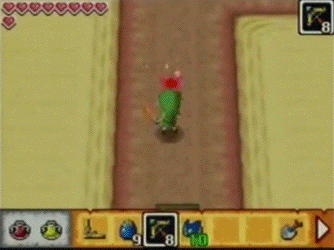
Game Specific:
Guitar Hero: The Guitar Hero controller consists of a neck with fret buttons and a strum bar. Players press the fret buttons and strum to match on-screen notes and rhythms.

Donkey Kong Bongos: These controllers are equipped with pressure-sensitive pads that detect claps and drumming. Players clap or drum to control in-game actions.

Buzz/Scene It (Xbox): These controllers are buzzers with buttons. Players use these to buzz in and answer trivia questions during quiz games.

Dreamcast Sega Bass Fishing remote: This fishing controller resembles a fishing rod. Players reel in and cast their lines, mimicking real fishing actions in the game.

Pro-Gaming:
Pro-Gaming Pads - Custom Set-ups: Pro-gaming pads and custom set-ups are prevalent in professional esports, especially in games like first-person shooters (FPS) and real-time strategy (RTS). Players often use customized controllers, featuring programmable buttons, increased sensitivity, and ergonomic designs for quick and precise actions. Popular games in this realm include titles like "Call of Duty," "Counter-Strike: Global Offensive," and "StarCraft II." The custom set-ups are tailored to individual player preferences, allowing for optimal performance in competitive gaming environments.
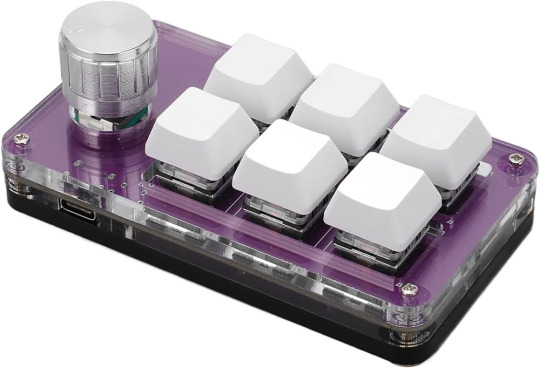
Joysticks: Joysticks have a rich history in gaming, especially in flight simulation and space combat games. Titles like "Microsoft Flight Simulator" and "Elite Dangerous" benefit from the precision and immersive control that joysticks offer. The unique range of motion allows players to maneuver aircraft and spacecraft with greater accuracy than traditional controllers. Joysticks are favored by enthusiasts seeking a more realistic and engaging gaming experience.

Steering Wheels/Rigs: Steering wheels and rigs are synonymous with racing simulations, offering a more immersive and realistic driving experience. Games like "Gran Turismo," "Forza Motorsport," and "Assetto Corsa" are popular titles where steering wheels are widely used. The force feedback and responsive controls provide a heightened sense of control and engagement, making them essential for serious racing game enthusiasts.

Retro:
Menacer (Sega Megadrive): The Menacer was a light gun for the Sega Megadrive, used primarily for games like "Lethal Enforcers" and "Body Count." It allowed players to aim and shoot on-screen targets, providing an arcade-like experience at home.

Zapper (NES): The Zapper was a light gun accessory for the NES, used prominently in games like "Duck Hunt." It relied on light sensing technology to register hits on targets, providing a unique and enjoyable gameplay experience.

Power Glove (NES): The Power Glove was a motion controller for the NES, attempting to translate hand movements into on-screen actions. While not widely successful, it remains an iconic piece of gaming history.

Jaguar (Atari): The Atari Jaguar featured a unique controller with a numeric keypad, designed to accommodate a variety of game genres. It was used for games like "Alien vs. Predator" and "Tempest 2000."

Arcade Games:
Racing Games: Arcade racing games, both traditional and unique, often use specialized controls such as steering wheels, pedals, and gear shifts. Classic titles like "Out Run" and modern adaptations like "Mario Kart Arcade GP" offer players a dynamic and immersive racing experience.

Gun Games: Arcade gun games like "Time Crisis," "House of the Dead," and "Terminator Salvation" utilize light guns, providing players with a realistic shooting experience. Unique features include reloading mechanics, cover systems, and force feedback, enhancing the arcade shooter experience.

Dance Dance Revolution: "Dance Dance Revolution" is a popular rhythm game that uses a dance pad. Players step on directional arrows in time with the music, offering a physically engaging and entertaining gameplay experience.

Tabletop and Physical Games:
Board Games: Board games encompass a vast range of genres, from classic titles like "Monopoly" and "Scrabble" to modern strategy games like "Catan" and "Ticket to Ride." These games often involve a combination of cards, dice, and tokens, providing a tactile and social gaming experience.

Card Games: Card games, whether traditional like "Poker" or modern deck-building games like "Dominion," rely on strategic play and often involve social interaction. They are versatile and enjoyed by players of all ages.
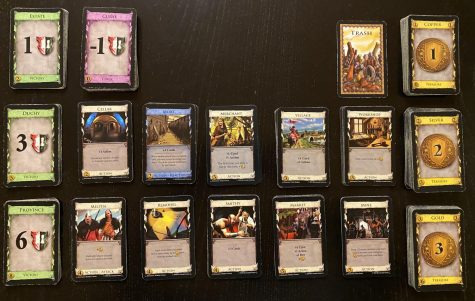
RPG’s (Dungeons & Dragons): Role-playing games (RPGs) like "Dungeons & Dragons" (D&D) involve a combination of storytelling, dice rolling, and character development. Players use rulebooks, character sheets, and dice to navigate imaginary worlds and embark on epic adventures.
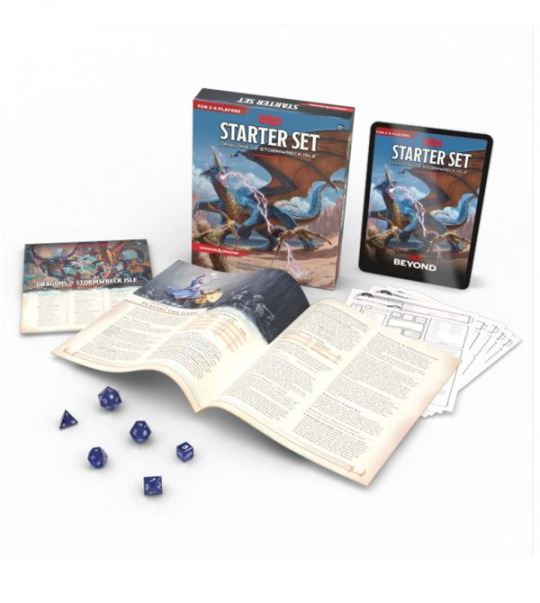
LARP’ing: Live-action role-playing (LARPing) takes gaming into the real world, where participants physically portray characters and engage in a shared narrative. LARPing often involves costumes, props, and immersive environments, blurring the lines between tabletop gaming and theatrical performance.

Fairground Games:
Coconut Shy: Traditional fairground games like Coconut Shy challenge players' skills in a carnival setting. Players attempt to knock over coconuts with thrown balls, showcasing a mix of precision and luck.
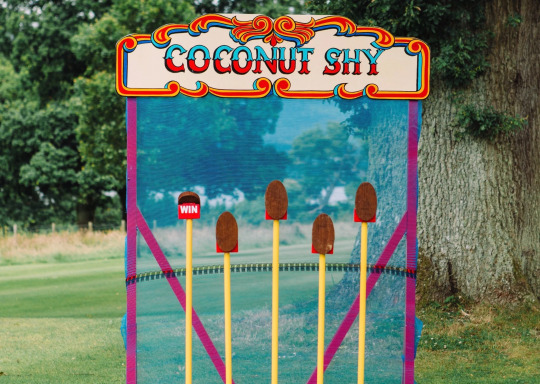
Other:
Quiz Games - Jackbox Games: Jackbox Games revolutionized party gaming by using mobile devices as controllers. Games like "Quiplash" and "Fibbage" involve answering trivia and creating humorous responses, making them accessible and entertaining for diverse player groups.

Dragon Quest's Nintendo Switch Slime Controller: The Nintendo Switch Slime Controller, inspired by the "Dragon Quest" series, features a unique design resembling the iconic Slime monster. While not altering gameplay mechanics, it adds a thematic and playful element to the gaming experience.

Now Play This – A Festival of Experimental Game Design: "Now Play This" is a festival that showcases experimental and unconventional game designs, pushing the boundaries of traditional gaming

Alternative controllers are not just a means to diversify gameplay experiences; they are powerful tools in fostering inclusivity within the gaming community. These controllers, whether they involve motion sensing, unique peripherals, or adaptive input devices, offer a pathway for individuals with disabilities to engage in the world of gaming. They redefine the boundaries of accessibility, making it possible for gamers of all abilities to participate fully and experience the joy of interactive entertainment. By tailoring gameplay experiences to different needs, alternative controllers play a pivotal role in ensuring that gaming transcends physical limitations, allowing everyone to share in the immersive and rewarding world of video games.
0 notes
Text
Crunching Numbers in Satta King
Video Games: A Journey Through Digital Realms
In the ever-evolving landscape of entertainment, video games have emerged as a dynamic and immersive medium that has captured the hearts and minds of millions worldwide. satta king From the pixelated wonders of the '80s to the cutting-edge graphics and storytelling of today, video games have come a long way. In this blog, we'll embark on a journey through the world of video games, exploring their evolution, impact, and why they hold a special place in our lives.
The Evolution of Video Games: From Pong to Virtual Reality
Video games have witnessed a remarkable evolution since their inception. It all started with classics like Pong and Space Invaders, where simple graphics and gameplay ruled the day. As technology advanced, so did the possibilities. The introduction of home consoles like the Atari 2600 and Nintendo Entertainment System (NES) brought video gaming into people's living rooms, revolutionizing entertainment.
The '90s saw the rise of iconic franchises like Super Mario, Sonic the Hedgehog, and The Legend of Zelda, while 3D graphics added a new dimension to gameplay. Fast forward to the 21st century, and we have witnessed the birth of high-definition gaming, online multiplayer experiences, and the advent of virtual reality (VR) gaming that blurs the lines between the real and virtual worlds.
The Impact of Video Games: More Than Just Entertainment

While video games are undoubtedly a source of entertainment, their impact goes beyond that. They have influenced various aspects of our lives:
Education: Educational games teach everything from math to history in an engaging and interactive way. Games like "Minecraft" have even found their way into classrooms.
Problem-Solving: Many video games challenge players to think critically, strategize, and solve complex puzzles, enhancing problem-solving skills.
Social Connections: Online multiplayer games provide a platform for social interaction, allowing players to connect and collaborate with others worldwide.
Career Opportunities: The video game industry has created jobs ranging from game development to esports, offering career opportunities to passionate gamers.
The Diverse World of Gaming: Genres and Communities
Video games come in a wide array of genres, catering to different tastes and preferences. From action-packed shooters like "Call of Duty" to sprawling open-world adventures like "The Witcher 3," there's a game for everyone. Additionally, gaming communities thrive on platforms like Twitch and Discord, where players share experiences, strategies, and even build careers as content creators and streamers.
The Art of Storytelling: Narratives in Video Games
One of the most exciting aspects of modern video games is their ability to tell compelling stories. Titles like "The Last of Us," "Red Dead Redemption 2," and "Final Fantasy" series have demonstrated that video games can deliver narratives on par with the best books and movies. Players become emotionally invested in the characters and the worlds they inhabit.
The Future of Gaming: What Lies Ahead
As technology continues to advance, the future of video gaming looks promising. sattaking Expectations include even more realistic graphics, immersive VR experiences, and innovative gameplay mechanics. With the advent of cloud gaming services and augmented reality (AR), the possibilities seem boundless.
Conclusion: More Than a Pastime
Video games are more than a pastime; they are a cultural phenomenon, a form of art, and a means of connecting with others. They have a unique ability to entertain, educate, challenge, and inspire. As we continue to explore the digital realms of video games, we find ourselves on an ever-expanding journey of discovery, where the boundaries of creativity and imagination are constantly pushed. Whether you're a casual gamer or a dedicated enthusiast, there's no denying the impact of video games on our world, and their influence is only set to grow in the years to come.
0 notes
Text
Activisi0n
Activision: A Glimpse into Gaming Dominance
Introduction
Activision is a prominent name in the gaming industry, recognized for its immense influence and contributions in the gaming world. Established in 1979, Activision has evolved into a global powerhouse, captivating millions of gamers worldwide. This article delves into Activision's journey, its significant achievements, key franchises, and the impact it has made on the gaming community.
History of Activision
Founding and Early Years: Activision was founded by former Atari programmers in 1979, making it one of the oldest video game companies. The initial aim was to publish third-party games for the Atari 2600.
Atari Lawsuit and Legal Precedent: In its early days, Activision faced a legal battle with Atari, which ended up setting a precedent for third-party game developers' rights.
Expanding Horizons: Over the years, Activision expanded its portfolio by acquiring and partnering with various studios, bolstering its standing in the gaming industry.
Key Franchises
Call of Duty: Perhaps one of Activision's most iconic franchises, Call of Duty has taken the gaming world by storm. The series has delivered numerous successful titles, setting records in sales and online multiplayer engagement.
World of Warcraft: Activision Blizzard is also the force behind World of Warcraft, a massively multiplayer online role-playing game (MMORPG) that has kept millions of players immersed in its fantasy world for decades.
Skylanders: Targeted at a younger audience, Skylanders revolutionized the toys-to-life concept, combining physical toys with video games.
Impact on the Gaming Community
Esports and Competitive Gaming: Activision has played a pivotal role in popularizing competitive gaming through its Call of Duty League and Overwatch League, providing a platform for professional gamers and esports enthusiasts.
Community Engagement: Activision has maintained a strong relationship with its player community, fostering engagement through regular updates, events, and an active online presence.
Conclusion
Activision's journey from its humble beginnings to becoming a giant in the gaming industry is a testament to its dedication, innovation, and ability to adapt to an ever-evolving market. With its iconic franchises and contributions to competitive gaming, Activision continues to shape the gaming landscape and delight millions of gamers worldwide.
1 note
·
View note
Text
All you need to know about Esports

Esports, short for electronic sports, refers to competitive video gaming, where players and teams compete against each other in various video games at a professional level. It has grown significantly in popularity and has become a major industry, with a massive global audience, professional players, teams, tournaments, and lucrative sponsorship deals. Here is a comprehensive overview of esports:
History of Esports:
Esports has been around since the early days of video gaming, with competitive gaming events dating back to the 1970s and 1980s. However, it gained mainstream recognition and popularity in the 2000s with games like Counter-Strike, StarCraft, and Warcraft III. Since then, it has continued to grow exponentially.
Popular Esports Games:
Esports encompasses a wide range of video games across various genres. Some of the most popular esports titles include:
League of Legends: A multiplayer online battle arena (MOBA) game developed by Riot Games.
Dota 2: Another popular MOBA game developed by Valve Corporation.
Counter-Strike: Global Offensive (CS:GO): A first-person shooter game.
Overwatch: A team-based first-person shooter.
Fortnite: A battle royale game developed by Epic Games.
Call of Duty: A long-running first-person shooter series with multiple esports iterations.
StarCraft II: A real-time strategy game.
Rocket League: A unique combination of soccer and vehicular mayhem.
Super Smash Bros.: A popular fighting game franchise.
Esports Organizations and Teams:
Professional esports teams are similar to traditional sports teams and have players specializing in various games. Some of its well-known organizations include Team Liquid, Fnatic, Cloud9, and T1.
Tournaments and Leagues:
Esports tournaments and leagues are the primary platforms for competitive play. Some of the most prestigious events include:
The International (Dota 2)
League of Legends World Championship
EVO Championship Series (fighting games)
The International (Dota 2)
Overwatch League
Counter-Strike: Global Offensive Majors
Esports Ecosystem:
Players: Professional esports players are highly skilled and often have contracts with esports organizations.
Coaches: Teams employ coaches to help players improve their skills and strategize.
Broadcasters and Casters: Esports events are often streamed on platforms like Twitch, with commentators providing live commentary.
Sponsors and Advertisers: Esports events and teams secure sponsorships and advertising deals.
Fans and Viewers: Esports has a massive global fan base, with viewership on platforms like Twitch, YouTube, and more.
Prize Money and Salaries:
It can be highly lucrative for top players. Prize pools for major tournaments can reach millions of dollars, and some players earn substantial salaries, sponsorships, and endorsement deals.
Esports Infrastructure:
Gaming Houses: Many esports teams live and practice together in gaming houses.
Training Facilities: Some organizations have state-of-the-art training facilities.
Esports Arenas: Its events are often held in dedicated arenas, and some stadiums host major tournaments.
Esports and the Olympics:
Esports has been considered for inclusion in the Olympic Games, although this topic remains a subject of debate and discussion.
Challenges and Controversies:
It has faced various challenges, including concerns about player health, doping, and player burnout. Additionally, the industry has grappled with issues related to gender diversity and representation.
Future of Esports:
It continues to grow, with increasing investment, media attention, and global recognition. The future may bring further professionalization, regulation, and expansion into new games and markets.
Esports is a dynamic and evolving industry, offering opportunities for players, teams, organizers, and fans alike. Its continued growth suggests that it will remain a significant part of the entertainment landscape for years to come.
0 notes
Text
Veteran CWL pro becomes first CoD star to make VALORANT big leagues
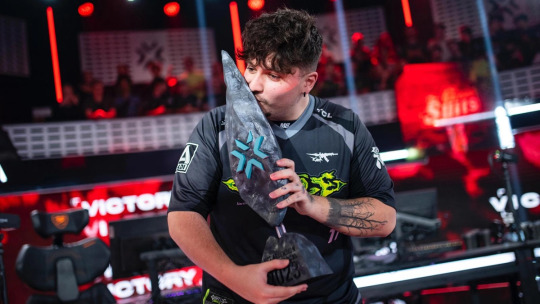
Following the end of the VALORANT Champions Tour EMEA Ascension competition on July 16, another player will add his name to the list of the chosen few who have had the opportunity to compete on the international stage in many distinct esports. Wailers Locart, a retired French Call of Duty professional who played at four CoD World League Championships across the late 2020s, is now set to represent Gentle Mates in the VCT EMEA top flight with his team next year after sweeping Apeks 3-0 in the promotion final. The French star said he was “speechless” following the team’s win, which saw them make a run through the lower bracket to make the final. Many have likened his move to PC to Nifty, a prolific CoD prodigy who made the switch to CS:GO in 2015. Nifty would go on to represent the likes of EnVyUs and Renegades in Counter-Strike after his short stint playing in 2014’s CoD: Ghosts. https://twitter.com/Wailers_WL/status/1680649493358714881 Wailers has a storied history in CoD, dating back to Advanced Warfare in 2015. Shortly after the release of Black Ops 3, Wailers was called up to represent Team Vitality for the inaugural CWL Pro Division, finishing top 32 at the 2016 World Championships. He would enjoy a two-year stint with the organization across Infinite Warfare and World War II before moving to the U.S. to play for Team Elevate, participating in seven CWL tournaments before returning home to Europe. He would spend the rest of his days competing in CoD Challengers for numerous teams. Come January 2023, Wailers moved on from pro CoD, announcing a shock switch to PC and VALORANT with Gentle Mates—an all-French roster—forming in January. Almost immediately they looked to lock themselves in for the VCT EMEA promotion slot, taking out both Challengers: Revolution splits with relative ease. Wailers and Gentle Mates were all but flawless in groups, losing out to Apeks before a heavy loss to Acend in playoffs meant a game away from elimination. The team bounced back in the lower bracket, finding revenge against Acend in the lower bracket final and Apeks in the grand final with impressive back-to-back best-of-five sweeps to win. Gentle Mates return in September for the Challengers Revolution Coupe de France in September, but all eyes will be on Wailers and the crew when they take to the stage next year for their VCT EMEA International League debut. Today’s win means they’ll lock themselves into VCT for two years. Moving from console to PC is tough enough, but to do so in another esport entirely whilst remaining competitive? Wailers is among rare esports company indeed, and time will tell whether he and Gentle Mates can push their hot VALORANT streak further in the new year against the very best in the region. Read the full article
0 notes
Link
Kelsie Grieg became the first female to qualify for the Call of Duty Challengers Elite tournament.
0 notes
Text
tying an esports team to a region is a great idea for more reasons than just the blind aping of trad sports that i can only assume was the reasoning behind the OWL's decision. like, look at what happens at international esports events: korean, chinese, european, and north american fans will all rally behind whatever teams from their regions end up making it through the brackets, to say nothing of how fervently vietnamese, latam, etc. fans will cheer when their regions so much as win a match.
having a team represent a place makes for fantastic marketing and provides pre-packaged narratives: new york and philadelphia, liverpool and manchester, city-based rivalries are as old as sports is. the reason the overwatch league fucked this easy win up is because they, very foolishly, declined to do what every other esport ever has done and institute a system of regional leagues, instead wanting to boast a "global league". but apart from the obvious logistical issues that the morons who came up with should thank their lucky stars COVID obviated immediately, this undercuts all the aforementioned benefits of tying your teams to cities!
a san francisco-LA match has immediate meaning to anyone, whether they're familiar with the esports histories and players of the teams or not. a shanghai-atlanta match, or a london-seoul match, or a vancouver-florida(?! not a city lads) match all mean basically nothing. plus, the way the OWL did it, making orgs set up teams with no branding connection to themselves, also made it hard to get invested in preexisting esports narratives: the lunatic-hai kongdoo panthera rivalry faded into memory when those teams became the 'seoul dynasty' and 'london spitfire', CoD fans eager for the envy/optic rivlary had to overcome the barrier to investment that was those teams being the 'houston outlaws' and 'dallas fuel'. actiblizz's own call of duty league would later rectify this awful decision by letting teams go by names like 'atlanta faze' and 'optic texas', but by then the OWL's fate was already sealed.
so what i'm saying is that a franchised, city-based model could have worked for an esports league, if it hadn't been for the boneheaded, institutionbally embedded blizzard mantra that they're the specialest boys alive and need to reinvent the wheel every time they do anything at all
overwatch leaguye was doomed from the start but NOT because of the idea of city baesd teams as many people claim that idea could have been great it was just the execution of it within the owl framework that was unworkable
271 notes
·
View notes